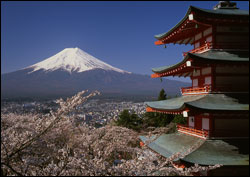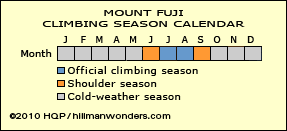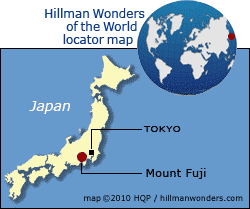Mount Fuji
 Why
Mount Fuji
is special
Why
Mount Fuji
is specialIt is more than being the world's most beautiful volcano. Mount Fuji is adored and revered by the Japanese and has become the tourism symbol of Japan around the globe.
VIewing Fuji
Unfortunately. the volcano is masked by clouds on most days. But on clear days, the view is magnificent. See it from:
- Hakone and Fuji Five Lakes
These famous resort regions sit at the volcano's base. - Tokyo
This city is 100 kilometers (60 miles) away, but you can see the mountain from some tall Tokyo structures. - Tokaido train
It passes near Mount Fuji. Book a right-side window seat when heading south from Tokyo - and a left-side one when going to Tokyo.
- Odds
Your chances of seeing the volcano improve in the winter, decrease in the summer. Ditto for early morning versus midday hours (and later). - Photo taking
Mount Fuji is most photogenic during the cold months when it's snow-capped. The cone is bare in summer.
It's a popular pursuit. About a quarter million people climb it each year. Nearly one-third are foreigners.
The three periods

- Official climbing season
It spans two months, from July 1st to August 31st. It has the best hiking weather and is the best choice for novice hikers. But the trails can become terribly crowded.
To lessen crowd impact, come on weekdays (avoid weekends and holidays). Also visit in early July or late August when children return to school. -
Shoulder seasons
They are June and September. Crowds are small or non-existent. But temperatures are colder and there is a greater chance of encountering bad weather, including fall typhoons. -
Cold season
It runs from October through May. Fewer people will be around to ruin your communion with nature. Only well-experienced hikers with proper equipment should climb Mount Fuji because ice, deep snows, sub-freezing temperatures, and strong winds create a dangerous environment. And if you are injured, medical help is remote.
If advance reservations for accommodations are unnecessary for you, don't head to Mount Fuji until the weatherman practically guarantees sun without rain or clouds.
Most popular place to begin your Mount Fuji climb
There are several trails up the volcano. Their trailheads are located in different areas on Mount Fuji. Most visitors opt for the Yoshida trailhead at Kawaguchiko Station #5. Main reasons:
- Easily reached from Tokyo
An express bus goes from Tokyo to Kawaguchiko Station #5 in just 2.5 hours. And there are multiple departures. - Less to climb
Its 2300 meter altitude is only about 1,500 meters (a mile) below the summit's. - Hiking time
The ascent averages 3 to 7 hours and the descent 2 to 4 hours. - Sunrise
You can view the sunrise before you reach the summit. - Facilities
The tiny tourism town has comfortable accommodations, restaurants, and shops. - Best overall experience for most visitors
The Yoshida trail is easier for novice hikers. And it has more mountain houses (convenient but Spartan accommodations), rest areas, and eateries than other trails.
Climb at night, reaching the summit early enough to see the celebrated sunrise. Some people break the nocturnal climb with a brief sleep over on a tatami mat in one of the high-altitude mountain houses.
Alternatively, you can double the experience. Hike up in midday, watch the sensational sunset, sleep at a mountain house, get up early in the morning to reach the summit to view the sunrise.
Mount Fuji tips and insights
Degree of difficulty
It's strenuous but not as challenging as some visitors would believe. Eight-year-olds and octogenarians reach the summit.
Stamina
You need to be in good shape. You also need to have had an active physical lifestyle back home to build stamina.
Good sense of balance
It's necessary for walking over the rocky areas near the summit. A hiking stick, which you can buy locally, is handy.
Climbing gear
Essentials include hiking shoes with good traction and ankle support, a waterproof parka or poncho, layer-able clothing, gloves, hat, sunglasses, and sunscreen.
For night hikes, bring a flashlight. Even better, wear a head lamp, as many Mount Fuji hikers do. It keeps both hands free when maneuvering among large rocks.
Altitude sickness
The air is thin near and at the summit. This can induce altitude sickness. Temporary symptoms include dizziness, fatigue, nausea, and augmented breathing difficulties. To avoid or minimize altitude sickness, don't travel too quickly from a low-altitude place to a high one.
Trail congestion
The trail can be heavily congested during the peak season. And the higher you go, the worse the situation becomes because the trail gets steeper and rougher. The line lengthens and moves at a snail's pace. This is particularly true when nearing the summit at night to see the sunrise.
Height
It is 3,776 kilometers (12,386 feet) in altitude, making it Japan's tallest mountain.
Eruptions
It is a dormant, not dead volcano - and is overdue. It has a 300-year cycle - and it last erupted in 1708.
Name
"Mount Fuji" is a western name. Japanese call it Fuji-san.
Symmetry
Unlike most large volcanoes, it has a near-perfect symmetrically one.
Worship
Ancient Japanese revered it and some ascended it for devotional reasons. However, women were forbidden to scale it until about 140 years ago.
Risk
Typically, several climbers die each year. The primary cause is lack of caution.
Ultimate nocturnal climb
Do it on a full moon. The landscape becomes eerily beautiful.
Expensive
Food, drink, accommodations, and hiking supplies are very costly. And the higher you go, the greater the prices.
Location in Japan



